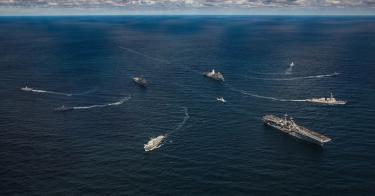Carlos del Toro marked his first anniversary at the helm of the Navy Department with a 1,141-word message to the Navy and Marine Corps extoling his accomplishments to date. But there was one glaring omission in his list of achievements: any indication that the Navy is better able to fight and win wars than it was one year ago.
The Navy Secretary cited progress made on many fronts: Sexual Harassment and Sexual Assault, Mental Health, Education, Housing, Keeping [personal] Costs Down, Child Care, Spouse Employment, and the Exceptional Family Member Program.
These are important areas, to be sure. Basic things like potable drinking water, living quarters that aren’t moldy, and compensation that comes close to matching current economic realities are essential to recruiting and retaining the manpower the Navy needs. Clearly del Toro’s mind was on personnel matters, but he missed an opportunity to reflect on why we have a Navy in the first place, and the purpose, importance, and value of serving as sailors and Marines.
Many occupations entail travel, long hours and missed holidays at home. Police, fire fighters, nurses, and even long-haul truck drivers, face such conditions. Some of these jobs include real hazards; among the riskiest things a police officer can do is respond to a domestic abuse call which can quickly spiral into violence. But many of these occupations are supported by labor unions, have defined work hours, or compensate extended days with scheduled time off or overtime. Sailors, Marines, and their families, on the other hand, deal with deployments, worn-out equipment and moving their families every few years. They compete for promotion within a rigidly hierarchical system and, lest we forget, face the potential for service in combat.
>>> The Navy’s Fleet Plan Has Two Strikes Against It
Why would someone put up with the challenges of military service when they could find other callings that pay more, separate them from their families less, have better opportunities to advance, and carry less risk? Base pay for a junior enlisted service member with less than 10 years of service averages $32,100 per year, while the average pay for a police officer is $55,500 and truck drivers $71,000 per year.
People will put up with an awful lot if they feel that what they are doing is noble and they have the tools and training needed to accomplish the job. Sadly, the military services across the board are coming up short in these areas. Little wonder all our military services are struggling to meet their recruiting goals for FY 2022.
In the Indo-Pacific, the Navy faces a three-to-one numerical disadvantage in fleet size compared to China’s navy. The disadvantage is expected to grow to nine-to-one within three years, and there is no credible plan in place to change those odds in the next 20 years. The Marine Corps has grand plans to reorient itself to better counter the battlefield threats posed by China but needs more ships—and a new class of ship—to do so. The Navy is poorly postured to deliver either. And both services are straining to provide the training needed to ensure our soldiers and Marines are ready for combat.
Del Toro said nary a word about any of this in his “year in review.” Yes, there is much to be said about bucking-up morale and talking about the good things being done. But the average sailor and Marine and their family members have eyes. They see the reality that surrounds them. Del Toro’s list of fine things done in his first year could easily have been nested alongside an accounting of the challenges facing the Navy and the importance of sailors and Marines doing what they do, wonderfully supported by their families. But he didn’t. What message does that send to the Marine or sailor far from home?
>>> The Administration and Congress Must Act Now to Counter the Worsening Military Recruiting Crisis
The naval services must be prepared for war so that, when called upon, they will be able to defeat enemy forces in battle. China likely cares very little about whether its sailors have access to education opportunities or whether their marine spouses are able to transfer their work skills from one location to another. But they are increasing their warfighting capabilities at a rapid pace while the U.S. fleet dwindles.
Here’s hoping that by the time his second anniversary address rolls round, del Toro will have marshalled sufficient material to hail advances in warfighting competency and perhaps provide some clear examples of the deterrent value of American naval power. It would be useful to learn how he proposes to overcome problems in attracting young Americans to join the Navy and the Corps, and to expanding the size of the fleet from its current 300 ships, a level so low it was last seen during the early 1930s. That would be a message worth reading.
This piece originally appeared in RealClear Defense




